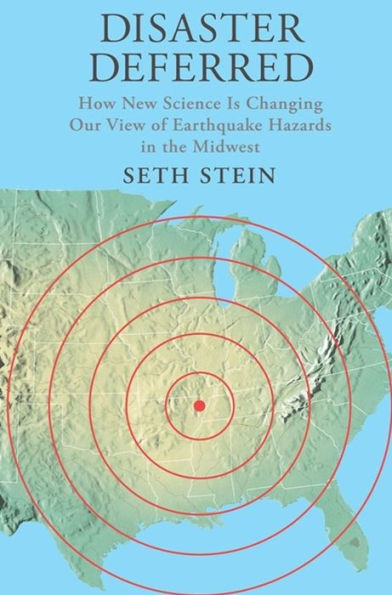A geologist takes readers inside contemporary earthquake research to offer a new account of the Midwest’s legendary New Madrid fault—“an exceptional read” (Choice).
In the winter of 1811-12, a series of large earthquakes in the New Madrid seismic zone shook the Midwest. These historic geological events are often incorrectly described as the biggest ever to hit the United States. Today the federal government ranks the earthquake hazard in the Midwest as high as California's and is pressuring communities to undertake expensive preparations for disaster.
In Disaster Deferred, geologist Seth Stein revisits these earthquakes, the legends that have grown around them, and the predictions of doom that have followed in their wake. He details how limited scientific knowledge, bureaucratic instincts, and the media's love of a good story have exaggerated these hazards. Debunking the hype, Stein explains how contemporary seismological techniques—including the use of GPS—painting a very different-and much less frightening-picture of the future. Using new geological ideas and data, he calls for a more sensible, less costly policy.
“An essential book for policy makers, economists, and notably educators.”—Choice
"1111428798"
In the winter of 1811-12, a series of large earthquakes in the New Madrid seismic zone shook the Midwest. These historic geological events are often incorrectly described as the biggest ever to hit the United States. Today the federal government ranks the earthquake hazard in the Midwest as high as California's and is pressuring communities to undertake expensive preparations for disaster.
In Disaster Deferred, geologist Seth Stein revisits these earthquakes, the legends that have grown around them, and the predictions of doom that have followed in their wake. He details how limited scientific knowledge, bureaucratic instincts, and the media's love of a good story have exaggerated these hazards. Debunking the hype, Stein explains how contemporary seismological techniques—including the use of GPS—painting a very different-and much less frightening-picture of the future. Using new geological ideas and data, he calls for a more sensible, less costly policy.
“An essential book for policy makers, economists, and notably educators.”—Choice
Disaster Deferred: How New Science Is Changing Our View of Earthquake Hazards in the Midwest
A geologist takes readers inside contemporary earthquake research to offer a new account of the Midwest’s legendary New Madrid fault—“an exceptional read” (Choice).
In the winter of 1811-12, a series of large earthquakes in the New Madrid seismic zone shook the Midwest. These historic geological events are often incorrectly described as the biggest ever to hit the United States. Today the federal government ranks the earthquake hazard in the Midwest as high as California's and is pressuring communities to undertake expensive preparations for disaster.
In Disaster Deferred, geologist Seth Stein revisits these earthquakes, the legends that have grown around them, and the predictions of doom that have followed in their wake. He details how limited scientific knowledge, bureaucratic instincts, and the media's love of a good story have exaggerated these hazards. Debunking the hype, Stein explains how contemporary seismological techniques—including the use of GPS—painting a very different-and much less frightening-picture of the future. Using new geological ideas and data, he calls for a more sensible, less costly policy.
“An essential book for policy makers, economists, and notably educators.”—Choice
In the winter of 1811-12, a series of large earthquakes in the New Madrid seismic zone shook the Midwest. These historic geological events are often incorrectly described as the biggest ever to hit the United States. Today the federal government ranks the earthquake hazard in the Midwest as high as California's and is pressuring communities to undertake expensive preparations for disaster.
In Disaster Deferred, geologist Seth Stein revisits these earthquakes, the legends that have grown around them, and the predictions of doom that have followed in their wake. He details how limited scientific knowledge, bureaucratic instincts, and the media's love of a good story have exaggerated these hazards. Debunking the hype, Stein explains how contemporary seismological techniques—including the use of GPS—painting a very different-and much less frightening-picture of the future. Using new geological ideas and data, he calls for a more sensible, less costly policy.
“An essential book for policy makers, economists, and notably educators.”—Choice
13.49
In Stock
5
1

Disaster Deferred: How New Science Is Changing Our View of Earthquake Hazards in the Midwest
298
Disaster Deferred: How New Science Is Changing Our View of Earthquake Hazards in the Midwest
298eBook
$13.49
$17.99
Save 25%
Current price is $13.49, Original price is $17.99. You Save 25%.
Related collections and offers
13.49
In Stock

Product Details
| ISBN-13: | 9780231522410 |
|---|---|
| Publisher: | Columbia University Press |
| Publication date: | 07/15/2020 |
| Sold by: | Barnes & Noble |
| Format: | eBook |
| Pages: | 298 |
| Sales rank: | 571,281 |
| File size: | 27 MB |
| Note: | This product may take a few minutes to download. |
About the Author
From the B&N Reads Blog
